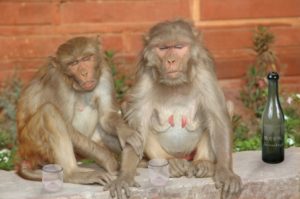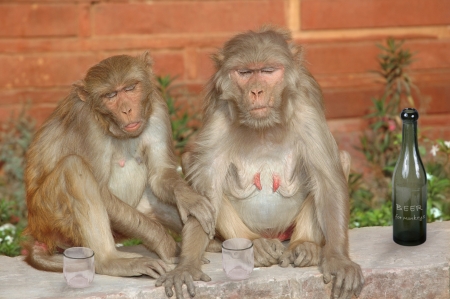
In the article, “What does it mean to be human?, the Smithsonian noted how DNA studies have demonstrated that on average, genetic differences between individual humans is about .1%. When the same kind of study is done comparing chimpanzees and bonobos with humans, the diversity is about 1.2%. The DNA difference of humans, chimpanzees and bonobos with gorillas is about 1.6%. “The DNA evidence leaves us with one of the greatest surprises in biology: the wall between human, on the one hand, and ape or animal, on the other, has been breached.” Given the close genetic relations we humans have to chimpanzees, apes and monkeys, perhaps it will be no great surprise to hear that researchers have shown they also have a weakness for ethanol. No, really, monkeys and chimpanzees like to get tipsy.
Watch this short BBC video of monkeys stealing alcoholic drinks from unaware, distracted humans at the beach. Keep watching and you’ll also see a suspiciously tipsy monkey who has trouble standing up. The video claims there are even tea totaling monkeys, at around the same percentage as humans. “In line with human habits, most [monkeys] drink in moderation. Twelve percent are steady drinkers and 5% drink to the last drop.” The theory is that like monkeys, we developed a taste for alcohol when we scoured the forest for ripe fermenting fruit.
This behavior also exists in the wild, independent of human drinking and fermentation behaviors. Here is a short video of a chimpanzee drinking fermented, alcoholic plant sap in the wild. The BBC also reported on a 17-year study of wild chimpanzees in the African country of Guinea where the chimpanzees repeatedly ingested naturally fermented palm wine from raffia palm trees. Local humans harvest the “palm wine” by tapping the trees at the crown and gathering the sap in plastic containers. Researchers have then seen chimpanzees—often in groups—climbing the trees to drink the fermented palm sap out of the containers.
The chimps even used drinking tools which the researchers called leaf sponges. They would chew handfuls of leaves and crush them into absorbent sponges. Then they would dip their sponge into the liquid and suck out the contents. In order to measure the extent of the chimp’s drinking, the scientists measured the alcohol content of the wine and filmed the chimps’ “drinking sessions.” Some individuals consumed the alcohol equivalent to of a bottle of wine. “[They] displayed behavioural signs of inebriation, including falling asleep shortly after drinking.”
Dr Catherine Hobaiter, from St Andrews University, said: “It would be fascinating to investigate the [behaviour] in more detail: do chimps compete over access to the alcohol? Or do those who drank enough to show ‘behavioural signs of inebriation’ have a bit of a slow day in the shade the next morning?”
The actual study, “Tools to Tipple: Alcohol Ingestion by Wild Chimpanzees Using Leaf-Sponges,” was published in the journal Royal Society Open Science. It reported that the ethanol in the palm wine varied between 3.1% alcohol by volume (ABV) and 6.9% ABV. Over 17 years the researchers observed 51 drinking events among the chimpanzees. They always used a leaf tool to drink, dipping it into the container with the fermented palm sap. “Individuals either co-drank, with drinkers alternating dips of their leaf-sponges into the fermented palm sap, or one individual monopolized the container, while others waited their turn.”
Some of the chimpanzees at Bossou consumed significant quantities of ethanol and displayed behavioural signs of inebriation. . . . Unlike examples of primates ingesting anthropogenic sources of ethanol elsewhere, such as introduced green monkeys at St Kitts targeting tourist cocktails [seen in the above video], chimpanzee attraction to fermented palm sap at Bossou does not result from former provisioning of ethanol by local people.
In another study, “Hominids Adapted to Metabolize Ethanol Long Before Human-Directed Fermentation,” Carrigan et al. suggested that an enhanced ability to metabolize alcohol in the last common ancestor of living African apes and humans may have resulted from an evolutionary change with an enzyme (ADH4). The changed enzyme enabled them to metabolize ethanol and happened “near the time that they began using the forest floor, about 10 million years ago.” The researchers thought their findings had implications not only for understanding the forces shaping hominin adaptations to ground-based living, but also for understanding the medical complexities of humans and alcohol today.
There is a short audio on The Academic Minute on “Human Alcohol Consumption” summarizing the above research. In much the same way humans are wired to enjoy sugar, salt and fat. Carrigan et al. suggest our genes adapted to promote alcohol consumption. The theory is this gave our ancestors a dietary benefit, as ethanol was present in fermenting fruit that fell from the trees onto the ground.
The results were very clear – the ancestor of humans and our close relatives, the chimpanzee and gorilla, acquired a mutation ~10 million years ago that enable them to metabolize ethanol much more efficiently than previous ancestors. This coincided with a major global climate change that caused the African forests to shrink, and suggests our ancestors adapted to ethanol in fruit to cope with a dwindling food supply.This does not mean our genomes are adapted to the much higher levels of ethanol found in modern alcoholic beverages … and so much like with sugars, salt and fat, we are now at risk of over-consuming something that was once scarce but important.
Another academic paper by Robert Dudley, “Ethanol, Fruit Ripening, and the Historical Origins of Human Alcoholism in Primate Fruigivory,” made a similar point from his research in the Republic of Panama. “Sustained evolutionary exposure to low-concentration ethanol will favor the evolution of metabolic adaptations that maximize physiological benefits associated with ethanol ingestion while concomitantly minimizing related costs.” Conversely, exposure to higher concentrations of ethanol not naturally encountered may cause harm. Dudley’s 2004 paper led to the publication of his 2014 book, The Drunken Monkey: Why We Drink Alcohol. Dudley’s work was the origins of what is called “The Drunken Monkey Hypothesis,” which proposed that: “A strong attraction to the smell and taste of alcohol conferred a selective advantage on our primate ancestors by helping them locate nutritious fruit at the peak of ripeness.” In the Middle Ages, people learned to distill spirits, concentrating the natural alcoholic content of fermented fruits and grains. “The once advantageous appetite for alcohol became a danger to human health and well-being.”
The last part of the hypothesis suggesting that the development of distillation in the Middle Ages changed the advantageous appetite for alcohol to a danger for human health is not accurate. Hundreds, even thousands of years before that time people understood the dangers of even fermented fruits to human health and well-being. There is a Chinese proverb that says: “To stop drinking, study a drunkard when you are sober.” An Egyptian proverb says: “Yesterday’s drunkenness will not quench today’s thirst.” The Greek poet Theognis, writing in the sixth century BC, made several comments on the problems with over indulging wine. Here are a few:
“Surely to drink much wine is an ill.” “Wine maketh light the mind of wise and foolish alike, when they drink beyond their measure.”My head is heavy with drink, Onomacritus, and wine constraineth me; I am no longer the dispenser of my own judgment, and the room runneth round. Come, let me rise and try if haply wine possess my feet as well as my wits. I fear I may do some vain thing in my cups and have great reproach to bear.” “Wine maketh light the mind of wise and foolish alike, when they drink beyond their measure.”“He that overpasseth the due measure of drinking is no longer master either of his tongue or his mind, but telleth reckless things disgraceful to sober ears, and hath no shame in what he doeth in his cups, a wise man once, but now a fool.”
There are also biblical passages condemning drunkenness, such as Proverbs 20:1, which says: “Wine is a mocker and strong drink brawler, and whoever is led astray by it is not wise.” Proverbs 23:29-35 is an extended passage about the negative consequences drunkenness. Verses 31-32 read: “Do not look at wine when it is red, when it sparkles in the cup and goes down smoothly. In the end it bites like a serpent and stings like an adder.” So dividing the history of human appetite for alcohol as advantageous before distillation and dangerous afterwards seems to miss the point.
However, the allure of alcohol as a motive for human tree dwelling ancestors to spend more time on the ground looking for it in fermented fruit fits well with another hypothesis for why humans changed from hunter-gatherers to sedentary farmers in the so-called Neolithic Revolution.
In his paper on the origins of brewing technology in ancient Mesopotamia, Peter Damerow noted where the technique of brewing beer has been discussed as a possible motive for the development of human culture in Neolithic times. The theory suggests that rather than using grain for other foodstuffs like bread, the discovery of the intoxicating effect of ethanol in beer “caused the transition from hunting and gathering to living in stable settlements, domesticating animals, and cultivating the soil.” This happened about 7,000 BC. While there is no conclusive evidence to support this hypothesis, “there can be no doubt that the emergence of agriculture was closely related to the processing of grain after the harvest, and that beer brewing soon belonged to the basic technologies of grain conservation and consumption.”
It is intriguing and somewhat perverse to say the lure of intoxication seems to have guided human development at two crucial crossroads.





